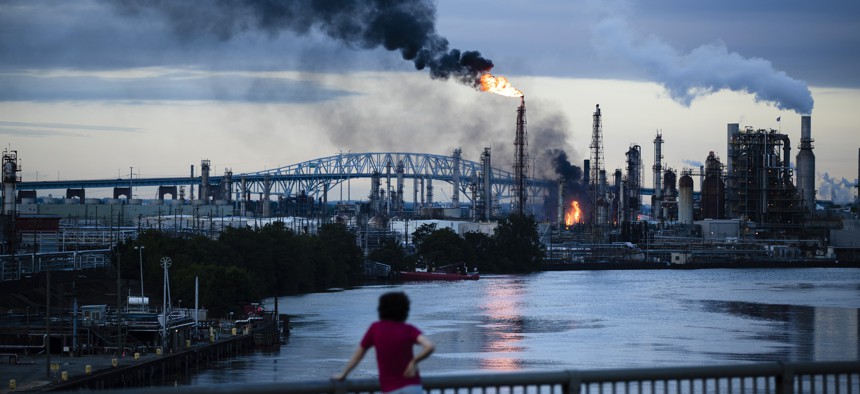Explosion at Philadelphia Refinery Isn’t First Time There’s Been Trouble at the Site

A resident watches the blaze, which continued for over 24 hours. Matt Rourke/AP Photo

Connecting state and local government leaders
The facility has repeatedly raised concerns for worker and local resident safety.
A massive explosion rocked an oil refinery in South Philadelphia last Friday, launching a fireball so powerful that it was seen by several satellites in space, and prompting an outcry from environmental advocates and city officials.
The explosion at the Pennsylvania Energy Solutions site happened just one week after the Philadelphia City Council voted to approve plans to construct a new liquified natural gas production facility, which will also be located on the southside of the city.
The facility where the explosion occurred has had a long history of fires dating back to 1879. Now producing 330,000 barrels of crude oil per day, the facility provides jobs to many residents in South Philadelphia, but that comes at a cost. The site is the city’s largest producer of particulate pollution, which can damage lungs and cause respiratory diseases like asthma. A 2018 survey of those who live near the refinery found an asthma rate of 34%, over quadruple the national rate of 8%. The area is also one of the poorest in the city, with a poverty rate close to 25%.
WOW! This video was taken as a massive explosion rocked the Philadelphia Energy Solutions refinery around 4:30 Friday morning. Up to the minute updates: https://t.co/NSiP8xy99L pic.twitter.com/ULf3fNslC6
— Action News on 6abc (@6abc) June 21, 2019
Last week’s blast led to five worker injuries, and residents near the refinery were advised to shelter in place. In a statement, PES said that they had not “determined the product that was burning, but [they] believe it was mostly propane.” Representatives from PES did not respond to a request for further comment.
Three explosions around 4 a.m on Friday impacted one particular unit in the refinery that uses hydrofluoric acid, a deadly chemical, as a catalyst in the chemical reactions that produce alkylate, a substance used to boost gasoline octane ratings. PES has said that no hydrofluoric acid was released, but residents are still worried about the environmental and health fallout of the explosion, given the long history of problems at the site.
David Masur, the executive director of PennEnvironment, an environmental advocacy group, said that this is the second fire in two weeks, but this time, the blaze was much worse. “We’re in this boat for a couple reasons,” he said. “Local officials and the owners of PES don’t want to talk about the high inherent risk of using volatile fossil fuel sources. Elected officials and owners have to concede that there is very high risk, and that feels like it gets brushed under the rug sometimes.”
Masur said he wasn’t surprised that the city council recently voted to construct another fossil fuel plant. “They could have done the right thing, but they did the wrong thing, and here we are days later,” he lamented. “This is a catastrophic case of misjudgement, and it unfortunately happened in a densely populated residential area,” Masur added, referring to Friday’s explosion.
Oil operations at the 1,300 acre site have been around since 1866, but at that point, most of the fuel produced there was used for kerosene lamps. Two refineries sit there now, originally owned by Sunoco, but sold in 2012 to PES.
The refinery has been plagued with infernos throughout its long history. In 1879, lighting struck 25,000 barrels of petroleum, setting them ablaze. A 1921 fire killed four people, and a 1944 fire killed another three workers. In 1966, flames reached 400 feet in the air, shutting down bridges and local roads. In 1975, four fires erupted, and during the most serious one, eight firefighters died while trying to put out the blaze. Several more fires appeared in the 1980s and 1990s.
There have been other types of dangerous incidents at the facility as well. In 2009, the release of 22 pounds of hydrofluoric acid sent 13 workers to the hospital. The workers later alleged that Sunoco, the refinery’s owner at the time, knew that conditions were hazardous, but let the men continue working regardless. The Occupational Safety and Health Administration cited Sunoco for safety violations after the leak. In 2013, United Steelworkers called for the elimination of hydrofluoric acid in refineries, and cited Philadelphia’s plant as one at risk for releasing the toxic chemical into the air.
The most recent blaze lasted over 24 hours, into Saturday afternoon. By Friday afternoon, the city health department said that they found no toxic chemicals in the air. But some residents continued to stay in their homes or tried to leave the area, as environmental activists and scientists urged caution. Some experts noted that because air monitoring measurements are meant to ensure first responder safety, a safe grade would not apply to sensitive populations, like those with asthma.
“Emergency responders and firefighters are very, very healthy people. People who are not healthy residents of the community — who might be elderly, or kids — are going to respond very differently to levels of pollution than those first responders,” Peter DeCarlo, an associate professor of engineering at Drexel University, told WHYY.
Philadelphia ranks the fourth highest amongst cities for asthma prevalence in the U.S.
The rate of asthma, Masur said, poses a huge problem for people who live near the refinery. “Even on the best days, the facility is a risk to public health,” he said. “Even if they’re doing the best they can, it’s still the largest single source air polluter in the city.”
An investigation into the explosion began Monday. A coalition of local and state offices are involved, including OSHA, the U.S. Chemical Safety and Hazard Investigation Board, and the Philadelphia Fire Marshal’s Office, among others.
Councilmember Helen Gym, one of only four on the Philadelphia City Council to vote against the new liquified natural gas plant that was approved last week, released a statement calling for the refinery to be shut down until “a full and independent investigation by city, state and federal officials have determined the cause of the explosions.” She also called for improved safety protocols, and said that the health and safety of residents and workers “must be assured, and PES should not be in charge of that determination.”
Masur said that PES has not claimed responsibility, and elected officials have not done enough. “The city said they’re creating a task force, and to me that seems like they’re trying to keep their head down until this blows over,” he said. “What is a task force going to tell us that we didn’t already know? We know the problems inherent to working with fossil fuels. It’s time for action.”
Emma Coleman is the assistant editor for Route Fifty.

NEXT STORY: 'Disaster City' Used to Train First Responders





